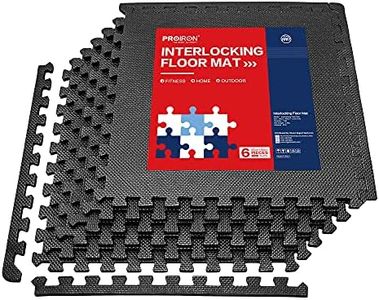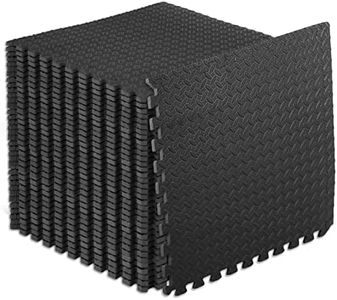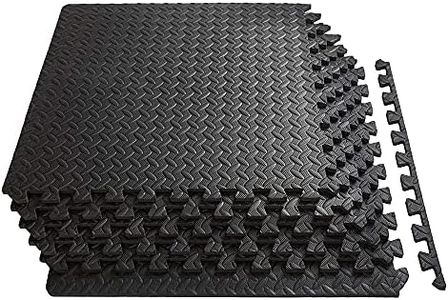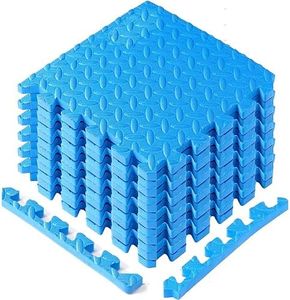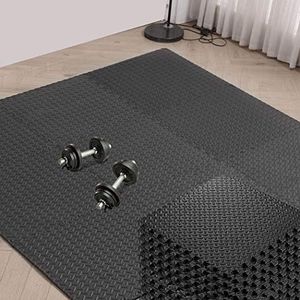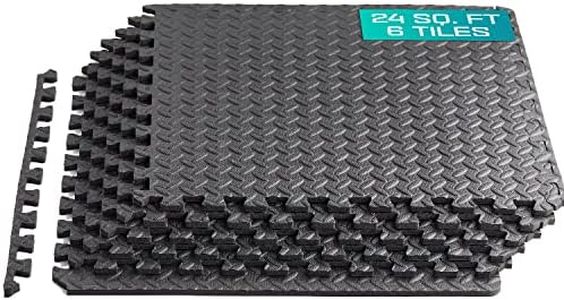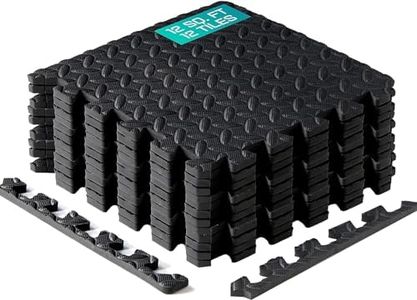We Use CookiesWe use cookies to enhance the security, performance,
functionality and for analytical and promotional activities. By continuing to browse this site you
are agreeing to our privacy policy
10 Best Interlocking Gym Mats
From leading brands and best sellers available on the web.Buying Guide for the Best Interlocking Gym Mats
When choosing interlocking gym mats, it's important to focus on comfort, safety, durability, and suitability for your intended exercises or activities. Gym mats come in various materials, thicknesses, sizes, and surface finishes, and these specifications can greatly influence your workout experience. Before making a decision, consider not only the type of workouts you'll be doing—such as yoga, weightlifting, martial arts, or high-impact cardio—but also the space available and how often you'll assemble or disassemble the mats.MaterialMaterial refers to what the gym mats are made from, with popular choices including EVA foam, rubber, PVC, and sometimes cork or carpet topping. This is important because it affects the mat’s comfort, shock absorption, durability, and grip. EVA foam is lightweight and suitable for general fitness and martial arts, while rubber is heavier and better for high-impact activities and weightlifting due to its sturdiness and slip-resistance. Choose the material based on your exercise needs—softer foams for activities like stretching or yoga, and denser, more durable materials for heavy equipment or high-impact workouts.
ThicknessThickness is a measure of how much padding the mat provides. It usually ranges from about 10mm (3/8 inch) to over 40mm (1.5 inches). Thinner mats (10–15mm) are easier to lay down and store, providing a stable but less cushioned surface best for general use, bodyweight exercises, or light cardio. Medium thickness (20–30mm) offers a balance, suiting varied workouts, while thick mats (30mm+) are ideal for high-impact training or protecting floors from heavy weights. To pick the right thickness, think about the activities you’ll do most; heavy impact or dropping weights calls for thicker mats, while lighter use can get by with thinner padding.
Surface TextureSurface texture describes how smooth or textured the top of the mat is, affecting traction, comfort, and ease of cleaning. Smooth surfaces are easy to clean and may be more comfortable for floor work, but textured surfaces provide better grip and help prevent slipping, especially during intensive movement. If you plan to do sweaty or high-movement activities, select a mat with a non-slip or textured finish. For stretching and resting, a smoother surface may be preferable.
Size and Tile ShapeThe size and shape of each interlocking tile determine how many mats you’ll need and how easily they’ll fit your space. Standard sizes range from small squares (about 2 feet by 2 feet) to larger segments. Larger tiles cover more area quickly but might be heavier or harder to store. Smaller tiles provide flexibility to fit odd spaces and are lighter to handle. Consider the layout of your workout area and whether you need to cover the whole floor or just specific zones. Also, look for puzzle-like edges that fit tightly to prevent gaps.
Ease of Assembly and PortabilityEase of assembly reflects how simple it is to put the tiles together and take them apart. Some mats have interlocking edges that snap easily, while others might require more effort to assemble. If you need to set up and take down your gym regularly or if the space is multipurpose, look for mats advertised as easy to assemble or move. If your gym is permanent, this is less of a concern, but portability is always helpful if you ever decide to reconfigure your space.
Durability and MaintenanceDurability refers to how long the mats will last under regular use and how well they stand up to wear, heavy equipment, and cleaning. Mats made from high-density materials like rubber generally last longer than softer foams. Maintenance involves how simple it is to clean the surface—look for mats that are water-resistant or easy to wipe down, especially if you’ll be sweating or working out in shoes. For high-traffic or commercial settings, prioritize highly durable, low-maintenance options.


